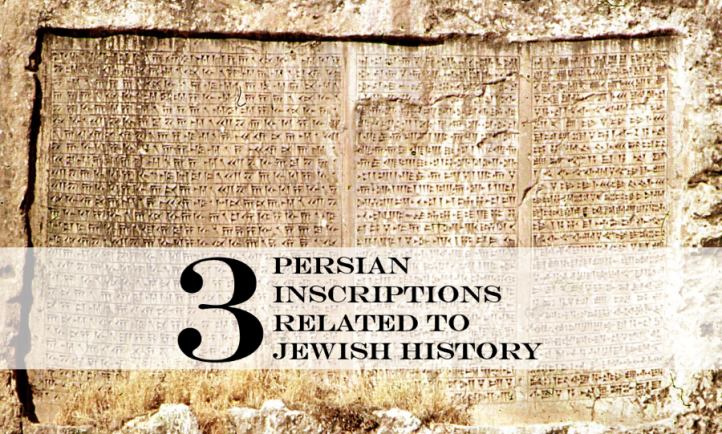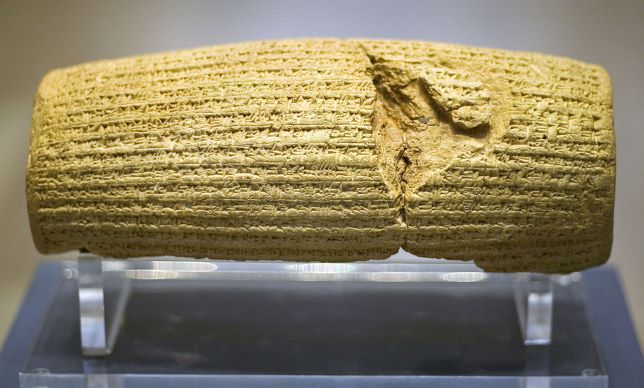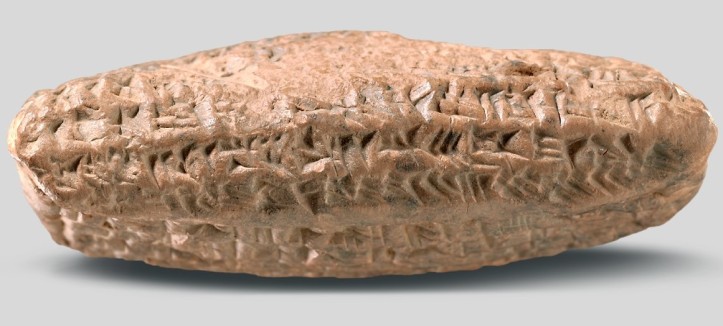
Throughout biblical history numerous empires rose and fell, many of which had interactions with the nation of Israel. In this series investigating the inscriptions of these ancient empires we’ve seen Egyptian inscriptions that refer to Israel, Assyrian inscriptions that name Hebrew kings and Babylonian inscriptions that shed light upon the period of the Israelite exile. In this article, we will look at three Persian inscriptions relating to Jewish history which confirm details in the Bible pertaining to an event, a place and a person.
The Cyrus Cylinder
In Ezra 1:1-3 we read about a remarkable policy that the Persian king Cyrus the Great instituted throughout his kingdom:
In the first year of Cyrus king of Persia, that the word of the LORD by the mouth of Jeremiah might be fulfilled, the LORD stirred up the spirit of Cyrus king of Persia, so that he made a proclamation throughout all his kingdom and also put it in writing: “Thus says Cyrus king of Persia: The LORD, the God of heaven, has given me all the kingdoms of the earth, and he has charged me to build him a house at Jerusalem, which is in Judah. Whoever is among you of all his people, may his God be with him, and let him go up to Jerusalem, which is in Judah, and rebuild the house of the LORD, the God of Israel—he is the God who is in Jerusalem. (ESV)
Ezra further records that “Cyrus the king also brought out the vessels of the house of the LORD that Nebuchadnezzar had carried away from Jerusalem and placed in the house of his gods” (1:7).
Early skeptics once doubted that an ancient king would allow captured people to return to their homes and rebuild their temples. Then, in 1879, Hormuzd Rassam discovered a clay cylinder with a cuneiform inscription the ruins of Babylon. The cylinder is a foundation text describing Cyrus the Great’s capture of Babylon and restoration of the city.1 Lines 30-35 of this text contain a declaration by Cyrus:
From [Babylon] to Aššur and (from) Susa, Agade, Ešnunna, Zamban, Me-Turnu, Der, as far as the region of Gutium, the sacred centers on the other side of the Tigris, whose sanctuaries had been abandoned for a long time, I returned the images of the gods, who had resided there, to their places and I let them dwell in eternal abodes. I gathered all their inhabitants and returned to them their dwellings.
In addition, at the command of Marduk, the great lord, I settled in their habitations, in pleasing abodes, the gods of Sumer and Akkad, whom Nabonidus, to the anger of the lord of the gods, had brought into Babylon.
May all the gods whom I settled in their sacred centers ask daily of Bêl and Nâbu that my days be long and may they intercede for my welfare.2
The inscription announces Cyrus’ general policy of returning exiles to their “dwellings” and allowing them to take their gods with them and rebuild their “sanctuaries.” The Jewish people had no idols, so the articles that had been taken from the Temple were returned. The Cyrus Cylinder then contains the general policy announcement, and the declaration in Ezra 1:1-3 is the specific announcement to the Jewish people. This confirms the biblical claim that Cyrus allowed the Jewish people who had been captured by the Babylonians to return to their homeland and rebuild their temple. In fact, many now hail the Cyrus Cylinder as the first declaration of human rights and a copy of it resides in the headquarters of the United Nations.

The DSf Foundation Inscription of Darius
The book of Esther begins with the great feast that Ahasuerus (called Xerxes in Greek) gave for all of his officials and servants at Susa, one of the four Persian capitals. The biblical text describes the splendor of the palace garden at Susa this way:
And when these days were completed, the king gave for all the people present in Susa the citadel, both great and small, a feast lasting for seven days in the court of the garden of the king’s palace. There were white cotton curtains and violet hangings fastened with cords of fine linen and purple to silver rods and marble pillars, and also couches of gold and silver on a mosaic pavement of porphyry, marble, mother-of-pearl and precious stones. (Esther 1:5-6 ESV).
The palace at Susa was constructed by Xerxes’s father, Darius. The foundation deposit inscriptions at the palace at Susa were discovered in three languages: Old Persian, Akkadian and Elamite.3 Known as the DSf, these foundation inscriptions describe the splendor of the palace in a way that is similar to the biblical description:
The palace which I built at Susa, from afar its ornamentation was brought…the cedar timber, this – a mountain named Lebanon – from there was brought. The Assyrian people, it brought to Babylon; from Babylon the Carians and the Ionians brought it to Susa. The yaka-timber was borught from Gandhara and from Carmania. The gold was brought from Sardis and from Bactria, from here was wrought. The precious stone lapis-lazuli and carnelian which was wrought here, this was brought from Sogdiana. The precious stone turquoise, this was brought from Chorasmia, which was wrought here. The silver and the ebony were brought from Egypt. The ornamentation with which the wall was adorned, that from Ionia was brought. The ivory which was wrought here, was brought from Ethiopia and from Sind and from Arachosia. The stone columns which were wrought, a village by name Abiradu in Elam – from there were brought. The stone-cutters who wroght the stone, those were Ionians and Sardians….Saith Darius the King: At Susa a very excellent work was ordered, a very excellent work was brought to completion.4
One can easily see the similarities in the descriptions of great wealth and splendor of the king’s palace: stone columns of marble, precious stones, precious metals, etc. Scholars have noted that the writer of the book of Esther must have been familiar with the Persian palace at Susa during the time period described in the book of Esther.

The Tattanai/Tattannu, Governor-Beyond-The-River Fragment
In Ezra 5 we read about the rebuilding of the Temple in Jerusalem as well as the opposition that arose to this:
Then Zerubbabel the son of Shealtiel and Jeshua the son of Jozadak arose and began to rebuild the house of God that is in Jerusalem, and the prophets of God were with them, supporting them.At the same time Tattenai the governor of the province Beyond the River and Shethar-bozenai and their associates came to them and spoke to them thus: “Who gave you a decree to build this house and to finish this structure?” (Ezra 5:2-3 ESV)
Confirmation of Tattenai, the governor of the province Beyond-The-River was found among a group of Persian tablets called the Tattannu Fragment Archive. One cuneiform tablet (VAS 4 152) is a promissory note dated to the 20th year of Darius I (502 B.C.) in which one of the witnesses of the transaction is a servant of “Tattannu, Governor Across-The-River.”5 There is a consensus among scholars that this governor Tattannu and the biblical Tattenai are one and the same.6

SUMMARY:
These three Persian inscriptions confirm an event (the public policy of Cyrus to return exiles to their home countries to rebuild their places of worship), a place (the palace of Darius I at Susa) and a person (Tattenai, governor Beyond-the-River) described in the Bible. They are evidence that the Bible is historically reliable.
While the Bible is not primarily a history textbook, it is nonetheless a historical document with different genres of literature, including passages that claim to record actual events (ie. the books of Kings and Chronicles in the Old Testament and the Acts of the Apostles in the New Testament). There are those who would seek to “throw off the shackles of having to believe in the historicity of the Bible.” However, the sheer number of chronological and historical markers throughout Scripture make such a view difficult to defend. Yes, it is important to interpret each passage in light of its genre of literature (ie. Proverbs). However, when it comes to the straightforward historical people, places and events described, there is no need to reinterpret what is described in order to dismiss the Bible’s historicity.
Archaeologist, Dr. Scott Stripling has stated, “After 150 years of archaeology in Israel, hundreds of synchronisms (connections) between the material culture and the biblical text have been established. At this point, it takes more faith to believe that the Bible is not true than to believe that it is true.”7
Endnotes:
1 Bryant G. Wood, “The Ongoing Saga of the Cyrus Cylinder: The Internationally-Famous Grande Dame of Ancient Texts” Associates for Biblical Research. August 18, 2010. http://www.biblearchaeology.org/post/2010/08/18/The-Ongoing-Saga-of-the-Cyrus-Cylinder-The-Internationally-Famous-Grande-Dame-of-Ancient-Texts.aspx (Accessed March 16, 2019)
2 “Cyrus Cylinder Translation” Livius.org. January 12, 2017. https://www.livius.org/sources/content/cyrus-cylinder/cyrus-cylinder-translation/ (Accessed March 16, 2019)
3 “DSf” Livius.org. November 16, 2018. https://www.livius.org/sources/content/achaemenid-royal-inscriptions/dsf/ (Accessed March 16, 2019)
4 Edwin M. Yamauchi, Persia and the Bible (Grand Rapids: Baker Book House, 1990), 296.
5 Matthew Jursa and Matthew M. Stolper, “From the Tattannu archive Fragment,” Wiener Zeitschrift für die Kunde des Morgenlandes 97 (2007): 243.
6 Ibid, 244.
7 Scott Stripling in a personal email to the author. July 26, 2016.

[…] on the governors to watch for further revolts. Scrutinizing his own province, Governor Tattenai3 is primed to suppress any rebellion under his jurisdiction. This is the time frame when God spurs […]
[…] to King Darius for affirmation that this was allowed. A group of Persian tablets called the Tattannu Fragment Archive, includes a cuneiform document – a promissory note dated to the 20th year of Darius, in which one […]
Awesome blogg you have here